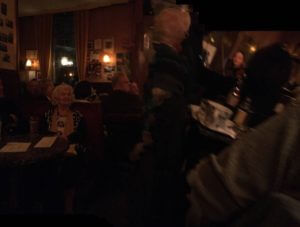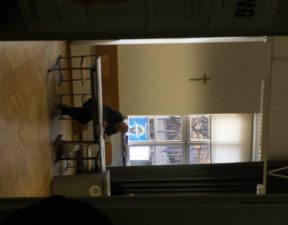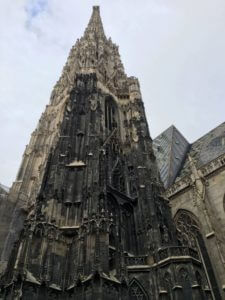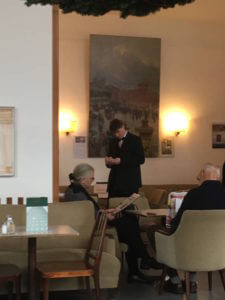 Last Sunday, Norbert Hofer lost the Austrian presidential election to Alexander Van der Bellen. This was a re-run; the original vote was held in May, with Van der Bellen, an elderly former Green Party leader, defeating Hofer by little more than 30,000 votes. Hofer’s party — the Freedom Party — challenged the results of the May election on the grounds of procedural irregularities: The glue on the absentee ballots, they said, was defective. The Constitutional Court ruled in their favor and called for a repeat.
Last Sunday, Norbert Hofer lost the Austrian presidential election to Alexander Van der Bellen. This was a re-run; the original vote was held in May, with Van der Bellen, an elderly former Green Party leader, defeating Hofer by little more than 30,000 votes. Hofer’s party — the Freedom Party — challenged the results of the May election on the grounds of procedural irregularities: The glue on the absentee ballots, they said, was defective. The Constitutional Court ruled in their favor and called for a repeat.
Hofer is widely described as a far-right candidate, although I don’t think this term helps readers to understand what he represents. That said, I’m not sure that I can explain what he represents, even after a week of asking Austrian people what they thought he represented. I was surprised by the vagueness or the evasiveness of the response when I asked people, “So, what does Hofer stand for? What’s his ideology?”
Agnes Palmisano, a Viennese coloratura soprano who doesn’t care for Hofer, repurposed the Otto Reutter song for the election: Take the old one.
I asked her why the young one rubbed her the wrong way. She told me she wasn’t political by nature, and she usually avoided political arguments because she knew that “very frankly, I’m not informed.” But she instinctively found Hofer unwholesome. Her father was ethnically Slovenian, she said. She didn’t like the idea of predicating Austrian citizenship on German ethnicity. She was uneasy, too, about the way people wouldn’t say, forthrightly, that they planned vote for Hofer, even though they obviously meant to do it. The unwillingness to debate his ideas openly seemed unhealthy to her.
One of the most interesting people I met was Evgeni Dönmez, a Turkish-origin politician for the Green Party. He felt that people who voted for Hofer were responding to a very real problem — to the problem the culture many of the new arrivals brought with them, to Islamist authoritarianism — which his own party was unwilling to acknowledge. Hofer’s party, he said, was “asking the right questions.” But their answers were “absolutely the wrong ones.” This conversation was worthy of a post of its own; I’ll come back to this after I transcribe my notes from the meeting.

…
In August of 2015, 71 refugees and migrants were found in the back of a truck on Austria’s A4 road. They had suffocated to death while being smuggled into central Europe.
A few days later, hundreds of refugees began walking from Budapest to Vienna. They were initially met with a wave of support. Austrian authorities begin ferrying refugees from the Hungarian border to Vienna, and then onto Germany via Salzburg. Some 170,000 refugees and migrants passed through Austria like this. The international media favorably contrasted Austria’s police and politicians with Hungarian authorities. Thousands of Austrians donated, volunteered to help the new arrivals, attended rallies in support of the refugees.
Not everyone in Austria was moved by this, however. Fear about immigration led to a surge in support for the Freedom Party, which immediately gained 15 percentage points in Upper Austria elections in September, then took 31 percent of the vote in Vienna elections in October.
On October 17, 2015, Hungary closed its border with Serbia and Croatia. By the end of 2015, thousands of migrants and refugees were trapped at Austria’s Slovenian border. Austria’s conservative Interior Minister, Johanna Mikl-Leitner, announced that Austria would build a fence to help control the flow. In the beginning of 2016, Austria built a barrier at the Brenner border with Italy. In March 2016, Macedonia, Croatia, and Slovenia shut their borders, with Austria’s encouragement. After the closure of that route and the strengthening of controls at Austria’s Italian border, refugees and migrants largely stopped trying to transit the country.
Austria accepted nearly 90,000 asylum applications in 2015 — one of the highest per capita numbers in Europe. But the government decided it couldn’t allow this to happen again, and announced a new annual upper limit on asylum applications of 37,500. The Austrian parliament adopted one of Europe’s toughest asylum laws. The bill permits the government to declare a state of emergency if migrant numbers suddenly rise and to reject most asylum-seekers directly at the border.
One year after the initial influx, Austria introduced one of Europe’s strictest asylum laws. Controls on the Italian border were strengthened. The Balkan route was cut off.
***
What most surprised me is that I expected to be able to see the effect this wave of migration had on the city. I’m not sure why I expected this, because rationally, 90,000 people wouldn’t be that visible in a city of 2.6 million. But the election I had come to see was represented, in the Anglophone media, as a contest between a left-wing candidate and an anti-immigrant populist. Why would an anti-immigrant populist gain purchase in Austria unless there was, visibly, a significant immigrant presence?
You might suspect that I had my globalist, rootless cosmopolitan blinders on, so I took as many photos and videos as I could. This is the city center, although most of the city looks like this, ethnically speaking:
I asked Lillibellt and her husband to take me to the neighborhoods people worried about. Here’s a so-called Turkish neighborhood:
Vienna is consistently ranked the world’s most prosperous and best-run city, and that prosperity is obvious. Well-made cars purr sleekly along wide roads free of traffic. On weekend mornings, the Viennese practice their equestrian skills and walk their greyhounds and Weimaraners in the woods. There are no bad neighborhoods; at least, none that I saw. Vienna is extremely wealthy compared to Paris. It’s extremely wealthy compared to Seattle, for that matter. It’s still the cradle of Alpine skiing, topped-rank in Mercer’s personal safety index based upon internal stability, crime, effectiveness of law enforcement.
Even Vienna’s public housing projects, in the center of the city, are luxurious and immaculately maintained. It’s true that they’re spooky to walk through at night, but only because the streets were so absolutely silent and empty.

And everything in Vienna looks a bit spooky to me, because it’s the dead of winter, and there’s something about Central Europe — Gothic architecture, in particular — that suggests ghosts, hauntedness, a permanent Halloween.
It would be epic arrogance to claim that after six days in Vienna, I fully understand the situation — particularly because I don’t speak German. My impression, though, was that Vienna looked barely affected by the refugee crisis.
Perhaps what caused people to feel overwhelmed was the fall of 2015, when, everyone agrees, the authorities lost control. When Merkel she said there would be “no limit” to the number of refugees Germany would accept, it caused people to think that literally millions of people would soon show up in Austria. I took her statement to mean (as I still think she probably intended), that Germany would set a good example and accept a generous number of refugees, this in the expectation that other countries would do the same. But it was understood as a genuinely insane statement, one that literally meant, “We will accept as many needy people as there are in the world, perhaps billions.” The failure to discuss the situation forthrightly gave the impression that the authorities generally, and Merkel particularly, had taken leave of their minds.
I wonder if the sense of crisis could have been forestalled had the Austrian Chancellor said from the first, “We’ve studied our budget and come up with a c oncrete number of refugees we can accept, feed, house, and educate until their country is safe or until they enter the workforce. That number is four-tenths of a percent of our population per annum. We will pay for this by making thesespecific cuts to our budget, and raising taxes by this amount. People who wish privately to sponsor more refugees are welcome to do so, so long as the refugees in question pass security and background checks, for which you as the sponsor must pay. Asylum applications must be processed at the border to ensure that no one enters the country on an illegitimate claim. Here is the plan. It is a specific plan.” It was the vagueness of the official response, I suspect, that made people lose their minds.
oncrete number of refugees we can accept, feed, house, and educate until their country is safe or until they enter the workforce. That number is four-tenths of a percent of our population per annum. We will pay for this by making thesespecific cuts to our budget, and raising taxes by this amount. People who wish privately to sponsor more refugees are welcome to do so, so long as the refugees in question pass security and background checks, for which you as the sponsor must pay. Asylum applications must be processed at the border to ensure that no one enters the country on an illegitimate claim. Here is the plan. It is a specific plan.” It was the vagueness of the official response, I suspect, that made people lose their minds.
 oncrete number of refugees we can accept, feed, house, and educate until their country is safe or until they enter the workforce. That number is four-tenths of a percent of our population per annum. We will pay for this by making thesespecific cuts to our budget, and raising taxes by this amount. People who wish privately to sponsor more refugees are welcome to do so, so long as the refugees in question pass security and background checks, for which you as the sponsor must pay. Asylum applications must be processed at the border to ensure that no one enters the country on an illegitimate claim. Here is the plan. It is a specific plan.” It was the vagueness of the official response, I suspect, that made people lose their minds.
oncrete number of refugees we can accept, feed, house, and educate until their country is safe or until they enter the workforce. That number is four-tenths of a percent of our population per annum. We will pay for this by making thesespecific cuts to our budget, and raising taxes by this amount. People who wish privately to sponsor more refugees are welcome to do so, so long as the refugees in question pass security and background checks, for which you as the sponsor must pay. Asylum applications must be processed at the border to ensure that no one enters the country on an illegitimate claim. Here is the plan. It is a specific plan.” It was the vagueness of the official response, I suspect, that made people lose their minds.  There are no hordes; Austria has not been overrun.
There are no hordes; Austria has not been overrun.
It’s true that if the borders had stayed open, and if everyone who wanted to come to the West had shown up in Austria, Austria would, indeed, have been inundated and unable to cope. That week, or ten days, extrapolated over a year, say, would be the nightmare people believe they can already see. But it didn’t happen, and it won’t.
It looked manageable to me. But if people think there’s no way to discuss immigration forthrightly, perhaps it doesn’t look manageable.
On the other hand, if a politician is telling you there’s a huge problem, but you can’t see it — why would you trust him, either? I was surprised that Norbert Hofer was defeated by such a big margin, but perhaps I shouldn’t have been.

No comments:
Post a Comment
Note: Only a member of this blog may post a comment.